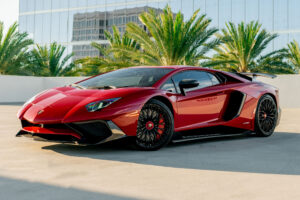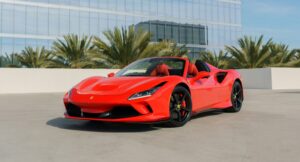The Chevrolet Corvette, an American icon synonymous with performance and style, has carved out a substantial place in automotive history.
Manufactured and marketed by General Motors’ Chevrolet division, the Corvette emerged as a thoroughbred sports car with roots stretching back to 1953. It embodies the innovative spirit of America’s love affair with the automobile.
Revered for its sleek design and engineering excellence, the Corvette held its ground in a market often dominated by European models and set new standards for what a domestic sports car could achieve.
Spanning multiple generations from the C1 to the current C8, the Corvette’s evolution reflects technological advancements and consumer expectations shifts over the decades.
Each iteration brought something new, from introducing a V-8 engine 1955 that elevated its performance to groundbreaking achievements like achieving 1 horsepower per cubic inch with certain engines.
The Corvette’s adaptability and commitment to innovation have cemented its reputation, allowing it to maintain its status as “America’s Sports Car.”
Leveraging a blend of power and design, the Corvette’s history exemplifies Chevrolet’s dedication to high performance and continuous improvement.
Pegged as a vehicle that’s desirable for the everyday driver and competitive on the race track, the Corvette continues to thrive, with each generation building upon the success of its predecessors.
The Corvette’s journey through the years showcases a relentless pursuit of power and style, making it an enduring symbol of American automotive culture.
Origins and Early Innovations
The Chevrolet Corvette emerged as an American sports car icon, renowned for its distinctive design and engineering feats. This section chronicles the pivotal moments from its inception to the remarkable performance upgrades that cemented the Corvette’s legacy.
Birth of an Icon
The Corvette debuted in 1953 at the GM Motorama as a concept show car. It was Chevrolet’s answer to the growing interest in sports cars in the United States.
The first generation, known as the C1, began an era that would see the Corvette become a symbol of American automotive prowess.
Performance Breakthroughs
Amidst early production, Zora Arkus-Duntov, a talented engineer, joined the Corvette team and played a crucial role in transforming the Corvette into a genuine performance car.
In 1955, he facilitated the installation of a V-8 engine under the Corvette’s hood—a significant upgrade from the prior six-cylinder, introducing robust power that would define the Corvette’s competitive edge.
Evolution of the Corvette
Over the decades, the Corvette has transitioned through eight major generations, each making definitive strides in performance, design, and technology.
From its inception, the Corvette has centered on a balance of power and style, with notable leaps in muscle and aesthetics with models like the Stingray and special editions that have become legends on the asphalt.
Stingray Emergence and Special Models
The 1963 Corvette marked a pivotal moment with the introduction of the Stingray.
The Stingray featured a distinctive split rear window for its first year and aggressive Mako Shark-inspired styling. This model introduced an independent rear suspension, significantly enhancing the driving experience and road handling.
Special models became a hallmark of the Corvette legacy, pushing the performance envelope further.
The L88 variant, produced from 1967 to 1969, was a racing-focused powerhouse with a big-block V-8 engine, boasting capabilities that overshadowed the already potent standard models.
Additionally, the Corvette ZR1, first seen in 1973, demonstrated a commitment to continuous advancement with its enhanced suspension and braking systems, becoming a beacon for performance enthusiasts.
Generational Developments
Generational shifts brought substantial changes as each new Corvette iterated on the success of its predecessors with attention to driving quality, power, and styling.
The C2 generation (1963-1967) brought the Corvette into the sports car limelight with its fiberglass body and a range of small-block and big-block engines.
The Corvette C3 debuted in 1968 with an iconic design, featuring bold chrome accents and continued Stingray branding until 1976.
The C4 emerged in 1984, showcasing a more modern aesthetic with sleeker lines and improved aerodynamics.
It was in the C4 generation that manual transmissions evolved from three and four-speed offerings to a six-speed manual in later models.
The C5, introduced in 1997, took a giant leap with a new platform that featured a more rigid structure and a transaxle layout for improved weight distribution, further honing the Corvette’s capabilities.
Key advancements in the C5 also included introducing the LS1 V-8 engine, continuing the legacy of substantial horsepower housed under the hood of America’s sports car.
Modern Era and Technological Advancements
The shift into the modern era of the Corvette brought about significant technological advancements and design innovation, solidifying its reputation as a premier American sports car.
Advancements such as introducing high-performance V8 engines and a commitment to endurance and racing solidified Corvette’s legendary status.
Shift to Contemporary Designs
With the arrival of the C6 Corvette in 2005, Chevrolet introduced a refined model that retained the Corvette essence while boasting modern upgrades.
The fiberglass body remained a staple but with a more streamlined aesthetic.
Notably, the C6 reintroduced exposed headlights for the first time since the C1, reflecting advancements in design.
This generation also saw the debut of high-performance variants like the ZR1 and Z06, featuring enhanced aerodynamics, carbon fiber components, and robust brakes and tires tailored to improve their track performance.
| Generation | Notable Features |
| C6 (2005-2013) | Exposed headlights, more defined contours, ZR1 and Z06 performance models |
| C7 (2014-2019) | Return of the Stingray designation, more aggressive styling, the introduction of the LT1 6.2-Liter V8 engine |
| C8 (2020-present) | Revolutionary mid-engine design, elevated performance, and handling characteristics |
Endurance and Racing Legacy
The Corvette has a storied legacy in racing, notably at events like the 24 Hours of Le Mans.
The Corvette Racing team consistently pushed the envelope in endurance racing performance.
The continual evolution of the Corvette resulted in enhanced powertrains with advanced fuel injection systems and robust V8 engines that delivered exceptional performance on the race track.
Moreover, technological improvements in the drive unit and transmission systems enabled the cars to handle the grueling demands of endurance racing while ensuring competitive laps on circuits worldwide.
Under the leadership of figures like Larry Shinoda, Corvette’s design and performance continually evolved to meet and exceed the demands of racing enthusiasts and owners.
Chevrolet’s commitment to combining luxury with performance continued to drive innovations in the C7 and the C8, culminating in the first-ever mid-engine Corvette.
This bold step into the mid-engine sports car domain further advanced the Corvette’s technological prowess, bringing about a transformation that has both impressed and excited automotive enthusiasts globally.
Production and Cultural Impact
The Chevrolet Corvette emerged from the visionary mind of Harley Earl, revolutionizing the American sports car landscape. It transitioned from a concept displayed at the GM Motorama in New York to a production model. The first unit rolled off the assembly line in Flint, Michigan, in 1953. The Corvette’s production later moved to St. Louis and settled in Bowling Green, Kentucky, a location synonymous with the brand today.
Initially, the Corvette sported a Blue Flame inline-six engine. The Corvette evolved, and by 1956, it was available with a V8, maturing into a performance icon. In 1968, the Sting Ray variant ushered in a new design age. Dramatic, sleek lines and the disappearance of exposed headlights in 2005 characterized it.
Key production milestones include:
- 1957: Introduction of fuel injection.
- 1963: Debut of the Sting Ray with its distinct split rear window and fiberglass body.
- 1973: Transition to urethane bumpers to meet safety regulations.
- 1984: Birth of the C4, intimating a partnership with Lotus for chassis and suspension development.
- 1997: Introduction of the fifth generation with a more rigid structure and improvements in performance.
From the prototype, Corvette’s cultural impact was significant. It symbolized freedom and power, and it is often featured in movies and owned by celebrities—the introduction of T-top roofs and the transition from roadster to convertible allowed enthusiasts to personalize their experience. Notably, color choices such as black in 1956 and the signature red in many models became iconographic.
In its over seven decades of production, engineers have continuously refined the Corvette, attesting to its endurance as an American icon through its constant evolution.

